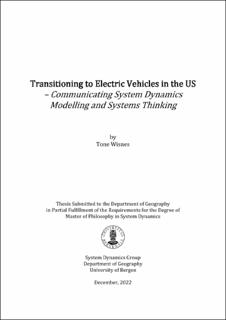Transitioning to Electric Vehicles in the US
Master thesis
Permanent lenke
https://hdl.handle.net/11250/3045590Utgivelsesdato
2022-12-12Metadata
Vis full innførselSamlinger
- Master theses [138]
Sammendrag
Concerns about growing greenhouse gas emissions from fossil fuels have become increasingly pressing in recent years and reducing energy use and shifting to cleaner fuels have become explicit political goals. The US is lagging behind the global average in transitioning from a fossil fuel-based vehicle fleet to zero emission vehicles. This thesis paper sets out to explore and clarify dynamic interactions that have been holding back adoption of electric vehicles in the US and to identify policies with potential to accelerate adoption in the coming years. Rooted in previous work and existing theories, system dynamics modeling and model simplification steps have been applied to derive new insights into the US passenger vehicle market. The thesis paper aspires to communicate these insights in a way that makes them accessible to a non-SD audience. The thesis findings point to increased familiarity with battery electric vehicle technology and learning curve effects on overall utility of battery electric vehicles, being the main drivers of adoption of battery electric vehicles in the US. The development in familiarity and utility is found to be onset by the global development – i.e. early adopters in other countries where the internal combustion vehicle dominance is less powerful or has been outweighed by successful battery electric vehicle incentives. The thesis model reveals the importance of considering possible influences from other markets for assumed isolated markets that are relatively underdeveloped. Several polices aimed to promote zero emission vehicle adoption, have been deployed in the US over the years, though the US has taken less of a supportive approach than China and several European countries. The thesis paper examines four separate policy categories and finds that Marketing Spending and Vehicle Purchase Subsidies are both feasible policy options, while Infrastructure Incentives have little potential to influence key performance indicators like market share distribution. Taxation of CO2 emissions from fossil fuel combustion is identified as the most efficient among the policies tested. This policy works to increase the overall relative utility of battery electric vehicles and cancels out some of the strength of the internal combustion vehicle dominance. The thesis paper makes available an interactive learning environment analysis tool that aspires to help users gain understanding of the dynamics at play when transitioning from a vehicle fleet consisting of predominantly internal combustion vehicles to a more diverse vehicle fleet. The analysis tool allows users to experiment with policies that might accelerate the development in battery electric vehicle adoption and explore impacts of adjusting underlying model assumptions, without requiring prior knowledge or skills, nor any subscriptions or software licenses The interactive learning environment enables interaction with model metrics but also aims to communicate structural model insights, which sets it apart from many other available projection tools.
